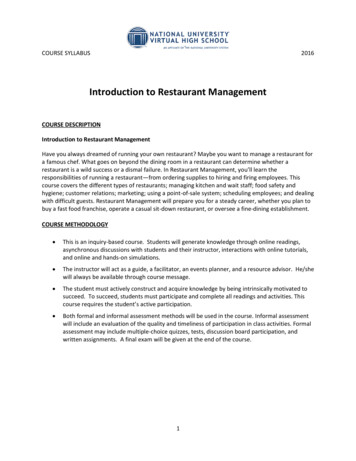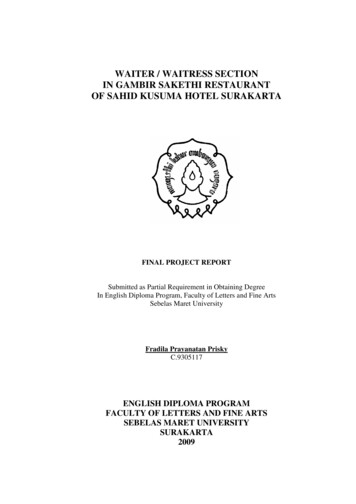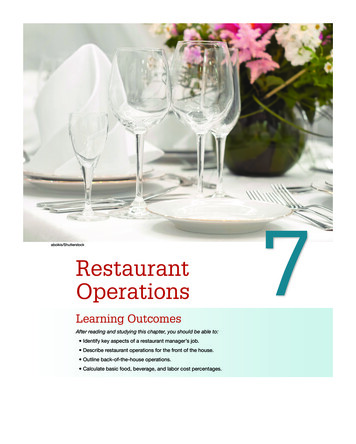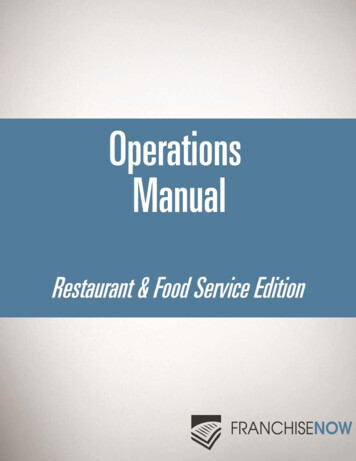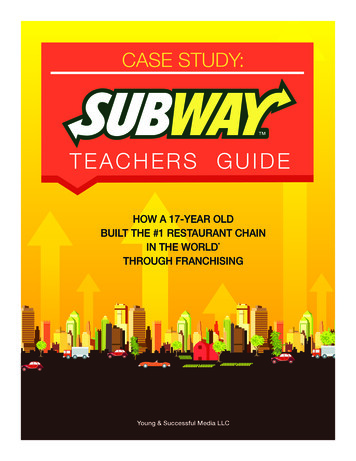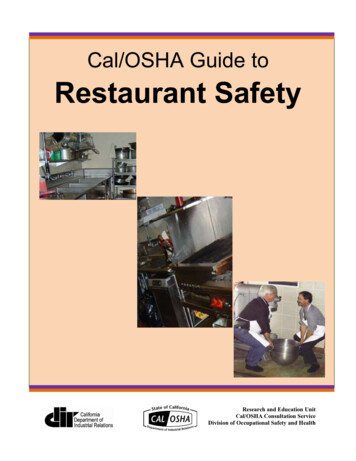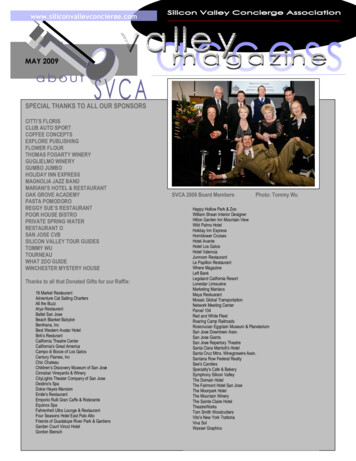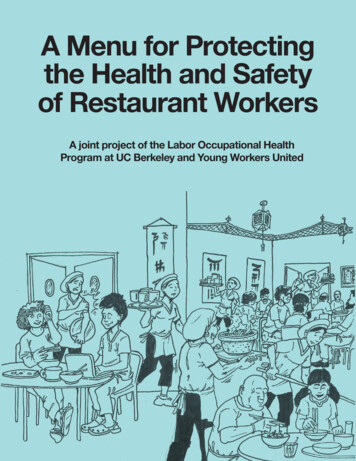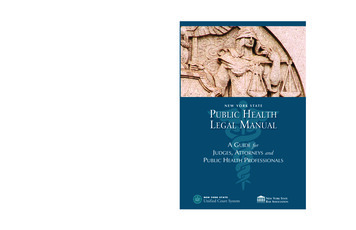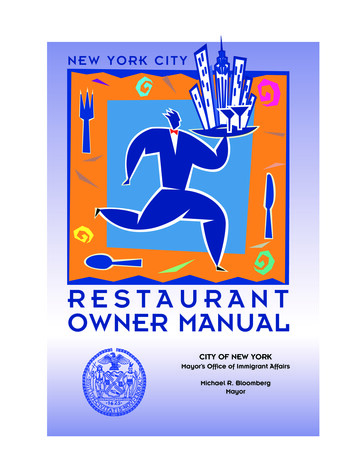
Transcription
NEW YORK CITYRESTAURANTOWNER MANUALCITY OF NEW YORKMayor’s Office of Immigrant AffairsMichael R. BloombergMayor
Design: NYC DCASGraphics, John Yue, Director of Media Design Services
N E WYORKC I T YRESTAURANTOWNER MANUALFEBRUARY 2006NOTICETHE NYC RESTAURANT MANUAL IS OFFERED AS A PUBLIC RESOURCE. IT DOES NOT CREATE NEWLEGAL OBLIGATIONS AND IT IS NOT A SUBSTITUTE FOR THE OFFICIAL SOURCES OF APPLICABLELAW. EVERY EFFORT HAS BEEN MADE TO ENSURE THAT THE INFORMATION PROVIDED IS COMPLETE AND ACCURATE AS OF THE TIME OF PUBLICATION.USERS OF THE MANUAL ARE PUT ON NOTICE THAT THE SUMMARIES, OPINIONS, SUGGESTIONS ANDREPRESENTATIONS CONTAINED HEREIN ARE NOT INTENDED, NOR SHALL THEY BE CONSTRUED,AS CONVEYING LEGAL ADVICE AND SHOULD NOT BE RELIED UPON AS SUCH. IF YOU HAVE A SPECIFIC COMPLIANCE MATTER WE ADVISE YOU TO SEEK LEGAL COUNSEL OR CONTACT THE APPLICABLE GOVERNMENT AGENCY.1
NEW YORK CITY RESTAURANT OWNER MANUALhis user-friendly manual is designed to help youbecome familiar with the basics pertaining to wages,hours of work, consumer protection, employment discrimination, public accommodations, and worker health andsafety, and more. We’re not giving you legal advice, nor willevery single law on the books be covered, but you will getessential facts and additional resources to fill in your knowledge and understanding of these laws.TYou’ve probably looked at the table of contents and hit your hand against your forehead exclaiming “Don’t Ihave enough to do running a restaurant in New York City? Do I have to learn all this too?” Don’t be overwhelmed. You’re probably adhering to a lot of these laws already. With a few complicated exceptions, thisstuff is pretty fundamental and you don’t have to sit down and read the whole thing at once. You can use thisas a resource to go back to if an issue arises and figure out what the appropriate steps to take are, or learn theright places to go for help.If you’re still feeling overwhelmed, remember - complying with the law is good for business! In producing thismanual, we’ve talked to a lot of employers who make a practice of adhering to employee-protection laws andhave found that they have more loyalty and fewer turnovers in their staffs. Employees who are treated welland earn a decent wage tend to be happier and provide better service to customers. But maximizing customersatisfaction is not the only reason to comply with the law. These laws are enforced by a number of federal,state and local government agencies and an employer who is caught breaking the law may be subject to harshpenalties including fines, jail time and license revocation. You’ll see many case studies throughout the manualconfirming this, so take a look.It is also good for your business to comply with laws regarding health and safety, food preparation, consumerprotection and public accommodations, which are discussed in this manual. Investing in health and safetyprecautions to comply with the law will likely save your restaurant the high costs of injuries or illnesses.Ensuring food safety and sanitation prevents food-related illnesses and promotes customer satisfaction.Complying with public accommodations and consumer protection laws builds trust and good will towardyour restaurant from customers.In addition to the government agencies and non-profit organizations listed in the back of this manual, weoffer monthly training courses for restaurant owners and managers at certain NYC Business Solutions Centers.(See page 41).iiThe following individuals and groups must be thanked for their contributions to this manual: Michael Hecht,New York City Department of Small Business Services; Patricia Smith and Donya Fernandez, The NewYork State Attorney General’s Office; Martha Mann Alfaro, Deputy Chief, Legal Counsel Division, New YorkCity Law Department; Dr. Jim Cone, The New York City Department of Health & Mental Hygiene, SheilaRothenberg, Institute for Labor & The Community, Inc.; Lisa Sirkin & Stella Yamada, The EqualEmployment Opportunity Commission, NY District Office; Richard McKeon, SeedCo; Evan Spelfogel,Epstein, Becker & Green; Florence Segura and Jimmy Yan, Mayor’s Office of Immigrant Affairs; DianaBreen, New York City Department of Consumer Affairs; Amy Sugimori, National Employment Law Project;Mika Dashman & Greg Sharma-Holt, Immigrant Right’s Clinic - CUNY School of Law & Purvi Shah, UCBerkeley, Boalt Hall School of Law, and the members and staff of the Restaurant Opportunities Center ofNew York (ROC-NY).
NEW YORK CITY RESTAURANT OWNER MANUALTABLE OF CONTENTSINTRODUCTIONiiWAGES AND HOURS OF WORK4Minimum WageTipped EmployeesOvertimeBreaks, Deductions & N LAWS17PENALTIES FOR VIOLATING WAGE & HOUR LAWSEMPLOYMENT OF MINORSEMPLOYMENT OF IMMIGRANT WORKERSNO-MATCH LETTERSRetaliationHiring, Firing & PromotionVerbal Abuse & HarassmentNational OriginLanguageReligionSexPregnancyEqual PayAgeDisabilitySEX-BASED DISCRIMINATION OF MINORS202121222223232425262629Sexual OrientationGender IdentityVictim of Domestic Violence, Sex Offense, or StalkingMarital & Familial StatusReview: Interview Questions34HEALTH & SAFETYOSHA Requirements:OSHA Solutions for EmployersLock-In’sExamples of Injury Prevention TechniquesWorkers Compensation & Disability BenefitsFamily and Medical LeaveLICENSING AND OPERATING LAWSRECOMMENDED BEST PRACTICES34353738393940Food Safety Inspections and PermitsHealth Academy: Food Protection CourseConsumer Protection LawsRESOURCES29293031334041444751Appendix A: Wage & Hour SummaryAppendix B: Restaurant Safety ChecklistAppendix C: Posting RequirementsAppendix D: Earn Benefits Program and ServicesNew York Labor Code Sections 193 and 196d andassociated regulationsEndnotes5758616364653
Wages and Hours of WorkNEW YORK CITY RESTAURANT OWNER MANUALWages andHours of WorkMinimum WageWhen do I have to pay my employees?For restaurant workers, full wages must be paid weekly and no later than 7 days after the end of theweek in which they were earned.If an employee is terminated, wages must be paid to that person no later than the regular payday forthe period during which the wages were earned.What is the minimum wage that I have to provide to my employees?New York State employers are subject to the State minimum wage, which is higher than the federalminimum wage. Employers are required to pay employees the higher state minimum wage.Currently, the state minimum wage for NON-TIPPED WORKERSis 6.75 per hour.On January 1, 2007 it will increase to 7.15 per hour.Can an employer pay an employee a set daily or weekly amount,e.g. “shift pay”?Generally, no. The only way this would be possible is if: (1) the employee works the exact samenumber of hours every day or week, and (2) the employee is getting paid at least the minimum wageand overtime for hours worked in excess of 40, and (3) the employer can prove that the employeehas been informed of the hourly rate on which the daily or weekly payment is based.Tipped EmployeesIs the minimum wage different for tipped employees?No, but an employer may take credit against the minimums for some portion of tips actually earnedby the employee as spelled out below.Tipped employees include food servers and delivery workers.4
NEW YORK CITY RESTAURANT OWNER MANUALIf you employ food servers and delivery workers you may deduct a limited amount of money fromthe statutory hourly minimum wage as a “tip credit” as long as the total earnings of that employee(salary and tips combined) are at least equal to the minimum wage and the hourly rate you paymeets the minimum requirements below.(Note that minimum wage was 6.00 per hour in 2005; is 6.75 per hour in2006; and will be 7.15 per hour in 2007).To pay a reduced minimum wage to tipped employees, you must:(1) Keep records of employees’ tips and(2) Inform employees that their wage is being decreased under the tip credit provision.Wages and Hours of WorkHow much must I pay tipped employees?Food Servers:Food servers include wait staff, bussers, & runnersDeducting the tip credit, the reduced minimum wage for food servers is 4.35 per hour during2006.To qualify for this reduced minimum wage, the food server must make at least 2.40 per hour in tips(in 2006), and the employer must keep records of the tips and inform the worker that their wage isbeing reduced under the tip credit provision.Example: A waitress who makes an average of 10 an hour in tips must still be paid at least 4.35 per hour in salary by her employer (in 2006).On January 1, 2006 the reduced minimum wage for food servers increasedto 4.35 per hour, and on January 1, 2007, it will increase to 4.60 perhour.Delivery workers:Deducting the tip credit, the reduced minimum wage for delivery workers is 4.60 per hour during 2006.To qualify for this reduced minimum wage, the food server must make at least 2.15 per hour in tips(in 2006), and the employer must keep records of the tips and inform the worker that their wage isbeing reduced under the tip credit provision.On January 1, 2006 the reduced minimum wage for delivery workersincreased to 4.60 per hour, and on January 1, 2007, it will increase to 4.85 per hour.Do I have to pay an hourly wage to employees who earn tips?Yes. Employers cannot require employees to work only for tips.Employees must pay minimum wages directly to employees no matter how much money employeesreceive in tips from customers.5
Wages and Hours of WorkNEW YORK CITY RESTAURANT OWNER MANUALBut, my employees earn a lot of money in tips. I think I should be entitledto a portion of it. Can I take a cut of their tips?No. An employer may not demand or accept any portion of an employee’s tips, nor may an employer require that tips be pooled or that tips received by service employees be shared with non-servicepersonnel.OvertimeTo whom must I pay overtime?Generally any wage earning employee must be paid overtime.The main exceptions to this rule are supervisors and managerial employees and professional andadministrative employees. You should consult an attorney if you have questions about the exemptions.When do I have to pay overtime?Whenever an employee works more than 40 hours in a week, the employer must pay that employee1 1/2 times the normal rate of pay for each additional hour.Example: if an employee earns the minimum wage of 6.75 per hour, that employee must be compensated at the rate of 10.13 per hour when working overtime.How much must tipped workers be paid overtime?Tipped employees must be paid at least 1 1/2 times the full minimum wage minus the tip credit. So thetipped overtime rates for workers making the tipped minimum wage for 2006 are as follows:Food Servers 7.73(1 1/2 times 6.75 is 10.13, minus 2.40 tip credit)Delivery Workers 7.98 (1 1/2 times 6.75 is 10.13, minus 2.15 tip credit)On January 1, 2007, it will increase to:Food Servers 8.18(1 1/2 times 7.15 is 10.73, minus 2.55 tip credit)Delivery Workers 8.43(1 1/2 times 7.15 is 10.73, minus 2.30 tip credit)My employees want to work more hours, and don’t care if they getovertime pay. Are they allowed to waive overtime pay?No. Overtime pay may not be voluntarily waived by an employee. Even if an employee asks foradditional hours of work and agrees to decline overtime pay, the employee is legally entitled toreceive time and a half.Can I require my employees to work overtime?There is generally no limitation on the number of hours in a day that an adult employee may berequired to work as long as the employee is properly compensated. An employer may have to provide special consideration for employees with disabilities1 and employees whose religious observancesare protected by law. These issues are discussed at pages 26-28.6There are limits for the number of hours a minor may work, which are described on page 10.
NEW YORK CITY RESTAURANT OWNER MANUALWhen are breaks and time off required to be given?New York law requires that employees be given one full day off each week.All employees who work a daytime shift of more than 6 hours must be given a 1/2 hour meal breakbetween 11:00 A.M. and 2:00 P.M.Employees whose shift begins prior to 11:00 A.M. and ends after 7:00 P.M. must also be given a 20minute break between 5:00 P.M. and 7:00 P.M.Employees who work a shift of more than 6 hours between 1:00 P.M. and 6:00 A.M. must be givena 45 minute break midway between the start and end of the shift.Wages and Hours of WorkBreaks, Deductions & RecordsCan I require a deposit from an employee to use expensive equipment?No. It is illegal to require employees to make deposits to use certain equipment. If an employeetakes or damages the employer’s property, the employer may not be paid the value of damaged property by withholding all or a portion of the employee’s wages. An employer harmed by negligent orcriminal behavior may only seek reimbursement after paying the employee, or pursue the matter in acourt of law. The employer cannot confiscate wages from an employee without a court order.What paycheck deductions are permitted?Employers may not make deductions from an employee’s pay, except those required by law or government rules and regulations, such as taxes. Any other deductions must: be explicitly authorized bythe employee in writing, be for the benefit of that employee, and be limited to deductions for uniondues, insurance premiums, charitable contributions, and other similar payments.Can I deduct pay for poor performance?No. It is illegal for an employer to deduct pay as a penalty for poor performance. However, anemployer is not required to pay an employee for hours not worked. You may deduct wages for lateness or absences, but only for the value of the time missed.The employer may take appropriate steps to encourage employees to remedy their problems withlateness, absence, or deficiency in performance.Can I deduct pay for meals I provide to my employees?Yes. An employer in the restaurant industry that provides meals to employees may deduct from the basic minimum wage of employees a meal allowance of 1.85 per meal for food service workers (which includes wait staff,runners, or bussers) or 2.05 per meal for all other workers (such as dishwashers and delivery workers).As of January 1, 2006 the meal allowance for food service workers increases to 2.00 per meal; as of January 1, 2007 it increases to 2.10 per meal.As of January 1, 2006 the meal allowance for all other workers increases to 2.30 per meal; as of January 1, 2007 it increases to 2.45 per meal.27
Wages and Hours of WorkNEW YORK CITY RESTAURANT OWNER MANUALDo I have to pay for and maintain my employee’s uniforms?It depends. If you require that a uniform be worn by employees, then you must provide it, replaceit when necessary and bear the cost of its cleaning and maintenance without charge or expense to theemployees, if the cost of purchase or cleaning would bring the employee’s wage below the applicableminimum wage.If your waiters are required to wear black pants and a white shirt, but not a specific uniform, thenthe employee bears the cost of purchase, cleaning and maintenance.What should I do if my employee is called for jury duty?Employees must be allowed time off for jury duty.Employees may not be fired or penalized in any way at work so long as the employee has given theemployer notice of the reason for his/her absence.If an employer has 10 or more employees, he or she must pay the first 40 of an employee’s wagesfor each day of the first three days of jury service. Other than this requirement, employers maywithhold wages for work missed due to jury service.What record keeping requirements apply to employers? Employers must provide employees a weekly pay stub that shows the following: Hours worked Hourly rate paid Gross wages Allowances (if any) claimed as part of the minimum wage (e.g. tip credit) Deductions Net wagesAND every employer must establish, maintain, and preserve for at least 6 yearsweekly payroll records for each employee.3 These weekly payroll records mustshow the following for each employee: Name and address Social security number Occupational classification and wage rate Hours worked daily and weekly, including arrival and departure time for split shifts or spread ofhours exceeding 10 hours Amount of gross wages Deductions from gross wages Allowances claimed as part of minimum wage (e.g. tip credit) Money paid in cash Student classification. Whether employee uniforms are laundered, cleaned, or maintained by the employer.8
NEW YORK CITY RESTAURANT OWNER MANUALWhat can happen to me if I break any of these rules?CRIMINAL PROSECUTION:First offense: failure to pay wages in accordance with the Labor Law is a misdemeanor. The maximum penalties can include fines of up to 20,000 and imprisonment for up to one year for eachseparate violation, and payment of restitution.Penalties for Violating Wage & Hour LawsPenalties forViolating Wage& Hour LawsSecond offense: failure to pay wages a second time within 6 years of prior offense is punishableas a felony, with fines, imprisonment and restitution as above.CIVIL PROSECUTION:Employees who have been underpaid may pursue civil remedies in Small Claims or Civil Court.The New York Attorney General, New York Department of Labor, or U.S. Department of Labormay investigate and/or sue employers for failure to comply with wage and hour laws.Employers may be made to pay 200% of the wages originally due, among other civil penalties.Corporate shareholders, owners, and managers may be held personally liable for unpaid wages insome cases.Who enforces these laws?Employees have the right to seek enforcement of wage and hour laws through government agencies,private attorneys and worker advocacy groups.What can happen if a worker is fired after filing a complaint against arestaurant for wage and hour law violations?It is illegal to retaliate against workers for making a complaint with an enforcement agency or formaking a complaint about wages. An employer who does so may be subject to civil and criminalpenalties.Prohibited retaliation includes, but is not limited to, reducing an employee’s hours, demotion, termination, change in duties, or change in hours.9
Employment of MinorsNEW YORK CITY RESTAURANT OWNER MANUALEmploymentof MinorsWho is covered by child labor laws?Anyone under the age of 18 is considered a minor. If you suspect that an employee is a minor you must obtain proof of his or her age. (You cannot use ignorance as an excuse forviolating child labor laws.)When may I hire an employee under the age of 18?Employment of minors under the age of 14 in the restaurant industry is illegal.Minors must have the proper employment certificate (working papers) from the Chancellor in thecity school district of the City of New York.What hours may my 14 and 15 year old employees work?When school is in session:14 and 15 year olds may not work more than 18 hours per week.They may work a maximum of 3 hours per day on weekdays and 8 hours per day on Saturday,Sunday, and holidays.They may not work more than 6 days a week.They may not work at night between 7:00 P.M. and 7:00 A.M.During school breaks or in the summer:14 and 15 year olds may work up to 40 hours per week, up to 8 hours a day.They can work between 7 A.M. and 9 P.M. from June 21st through Labor Day.They may not work more than 6 days a week.What hours may my 16 and 17 year old employees work?16 and 17 year olds can work 4 hours on any day preceding a school day.They can work 8 hours on Friday, Saturday, Sunday or a holiday,They may not work more than 28 hours a week;They may work until 10pm on any day preceding a school day,They may work until midnight on any day preceding a school day if the employer maintains thewritten consent of the parent or guardian and a certificate is provided to the employer at the end ofeach marking period by the minor’s school that the minor is in satisfactory academic standing;10
NEW YORK CITY RESTAURANT OWNER MANUALDuring school breaks, 16 and 17 year olds can work 48 hr/week, 8 hr/day between 6am and midnight.16 and 17 year olds who are not attending school may obtain a certificate from school authorities towork full time under certain conditions.They may not work more than 6 days a week.18 year olds are subject to the same rules as other adults.Do I have any additional responsibilities related to employment of minors?Yes. Employers must maintain employment certificates for all minors on file on the premises at therestaurant and such certificates must be made available for inspection by authorized agents.When a minor’s employment is terminated, the employer must return the minor’s certificate.The employer must make a schedule for all minors employed by the employer, setting forth thehours of beginning and stopping and the time allowed for meals, which must be kept conspicuouslyposted in the restaurant.Employment of Immigrant WorkersThey may work until midnight on any day preceding a non-school day if the employer maintainswritten consent of the parent or guardian;Are there any job-related duties that are prohibited specifically for minors?Yes. Minors cannot operate washing, slicing, mixing, or other high-risk machines.Minors cannot drive any vehicle as part of the job.If you are considering hiring minors to work in a kitchen using any type of machinery, includingfreezers, first check with the New York Attorney General or with the New York State Department ofLabor to make sure such employment is legal.11
Employment of Immigrant WorkersNEW YORK CITY RESTAURANT OWNER MANUALEmployment ofImmigrant WorkersHow do I determine who is eligible to work?All new employees must complete an I-9 Employment Eligibility Verification form. The Form I-9lists documents an employee may produce that are acceptable for establishing an employee’s identityand work authorization.If the employee has provided documents that s/he has chosen from the list of acceptable documentsto establish his or her identity and work authorization under the requirements of federal law, theemployer may not demand additional documents. The employer may not refuse to accept documents that on their face reasonably appear to be genuine.An employer may be liable for knowingly hiring an undocumented person, or for accepting falsifieddocuments with the Form I-9 when the government can prove the employer knew the employee wasundocumented.4For more information go to the U.S. Citizenship and Immigration Services website: http://uscis.gov.The “Frequently Asked Questions” Section is particularly helpful.What should be done with completed I-9 forms?The forms are not filed with the government. The employer must keep them on file for 3 years, or 1year after the employee’s job termination, whichever is later.What are my responsibilities concerning the authenticity of documentspresented to me by employees and prospective employees?You must examine the document(s) as specified by the Form I-9 and, if they reasonably appear to begenuine and to relate to the person presenting them, you must accept them. To do otherwise couldbe considered unfair employment discrimination on the basis of immigration status.Employer Ordered to Pay 2,881 in Back Pay For Refusingto Accept Liberian Refugee’s DocumentationAn employer was alleged to have illegally refused to accept an unrestricted Social Security card and driver’s license from a Liberian refugee asproof of employment eligibility for the Form I-9. These documents wouldotherwise have established her eligibility to work. In the settlement agreement, the employer agreed to provide full back pay to the would-beemployee totaling 2,881; a 500 civil penalty to the United States; andother injunctive relief, such as training of its human resources staff by theOffice of Special Counsel of the U.S. Department of Justice.512
NEW YORK CITY RESTAURANT OWNER MANUALThe I-9 Form should be completed upon initial hire.If an employee has temporary work authorization, the employer should note the expiration date ofthat authorization, and re-verify the employee’s documents prior to the expiration date.Re-verifying work authorization during a labor dispute may be considered retaliation. (see section onUnionization)No-match LettersCan I ask my employees to produce work authorization documentsat any time?Are undocumented employees covered by the same laws as otheremployees?Yes. Laws concerning minimum wages and overtime, the right to unionize, and protection againstharassment and other forms of discrimination apply to undocumented employees.13
No-match LettersNEW YORK CITY RESTAURANT OWNER MANUALNo-Match LettersWhat is a “No-match” letter?“No-Match” letters are sent by the Social Security Administration (SSA) to employers when socialsecurity numbers on a filed W-2 do not match the Administration records. The letter is intended toinform the employee of the discrepancy so that he or she can follow up with the Social SecurityAdministration to ensure that Social Security contributions are credited to the correct account.Why are SSA no-match letters sent out?No-match letters are intended ONLY to help SSA make sure its records and database are accurateand to ensure that SSA maintains an accurate earnings record for each employee. A no-match letterdoes NOT imply that the employer or the employee intentionally provided incorrect informationabout the employee’s name or Social Security number.Does a SSA no-match letter come from the Department of HomelandSecurity (DHS) [formerly known as the Immigration and NaturalizationService (INS)]6?No. SSA no-match letters do not come from DHS and are not intended to enforce of immigrationlaw.What am I required to do if I receive a no-match letter?A no-match letter obligates employers to: Check your own records for errors. Inform employees of the no-match letter so that employees know that their earnings are not beingcredited properly. Request that employees check their records for errors. Refer employees to the local SSA office for assistance. Submit any employer or employee corrections to the SSA.Do I have to take any action if an employee doesn’t provide correctedinformation?No. Employers are NOT required to take any action if the employee chooses to not provide corrected information. The SSA asks employers to respond to the no-match letter ONLY if they or theiremployees have corrected information.Am I required to fire an employee whose name appears on ano-match letter?No. You are not required to fire an employee whose name appears on a no-match letter; and in fact,the letter from SSA states this clearly. The 2004 SSA ‘No Match’ letter states:14“This letter does not imply that you or your employee intentionally provided incorrect informationabout the employee’s name or SSN. It is not a basis, in and of itself, for you to take any adverseaction against the employee, such as laying off, suspending, firing, or discriminating against the individual. Any employer that uses the information in this letter to justify taking adverse action against
NEW YORK CITY RESTAURANT OWNER MANUALIn some cases, employers use the no-match letter as an opportunity to fire or intimidate employees who may be speaking upfor their rights on the job. As a reminder, an employer who does any of the following may be violating the law:Unionizationan employee may violate state or federal law and be subject to legal consequences. Moreover, this letter makes no statement about your employee’s immigration status.” discriminate against employees of certain national origins or ethnic groups retaliate against employees because they filed a claim or complaint with an administrative agency orcourt retaliate against employees for union organizing activities or other union protected activities.Federal Agency Initiates Litigation Against Employerfor Firing Employee After Receiving ‘No Match’ LetterAn employer was alleged to have illegally fired a Mexican worker one dayafter seeing the worker protest over unjust working conditions in front ofthe restaurant. The employer claimed to have fired the employee on thebasis of receiving a “No-Match” letter from the Social SecurityAdministration. Nevertheless, the National Labor Relations Board (NLRB)initiated litigation against the employer for retaliating against the workerfor concerted protected activity. The employer ended up settling the caseout of court.Must I require an employee to bring in proof of their work authorization if Ireceive a no-match letter?No. The receipt of a no-match letter, by itself, does not give employers notice that a worker is notauthorized to work and does not trigger any duty to ask for such proof.Am I ever required to terminate an employee for reasons related to workauthorization?Yes. An employer who has “actual or constructive knowledge” that the employee does not havework authorization has an obligation to terminate employment. Receiving a no match letter is notthe same as having such knowledge. However, if an employee informs you that he or she is not eligible to work, you have “actual or constructive knowledge,” and you are required to terminate that person’s employment.15
Employment Discrimination LawsNEW YORK CITY RESTAURANT OWNER MANUALUnionizationEmployees have the right to form or attempt to form a union with other employees in a restaurant. Employees have the right to engage in protected concerted activity, including striking, toobtain better working conditions.7 Employees also have the right to resist union organizingand decline to be a part of the union. You should consult an attorney to understand the rights andobligations of the employer. Employees also have the right to get together with co-workers, andspeak to their employer or otherwise attempt to make work better or safer without the assistance of aunion (This is known as “protected concerted activity”).What am I prohibited from doing if a union organizing campaign happensat my restaurant?An employer may not threa
restaurant owner manual february 2006 notice the nyc restaurant manualis offered as a public resource. it does not create new legal obligations and it is not a substitute for the official sources of applicable law. every effort has
